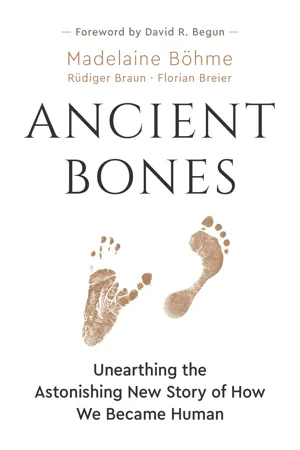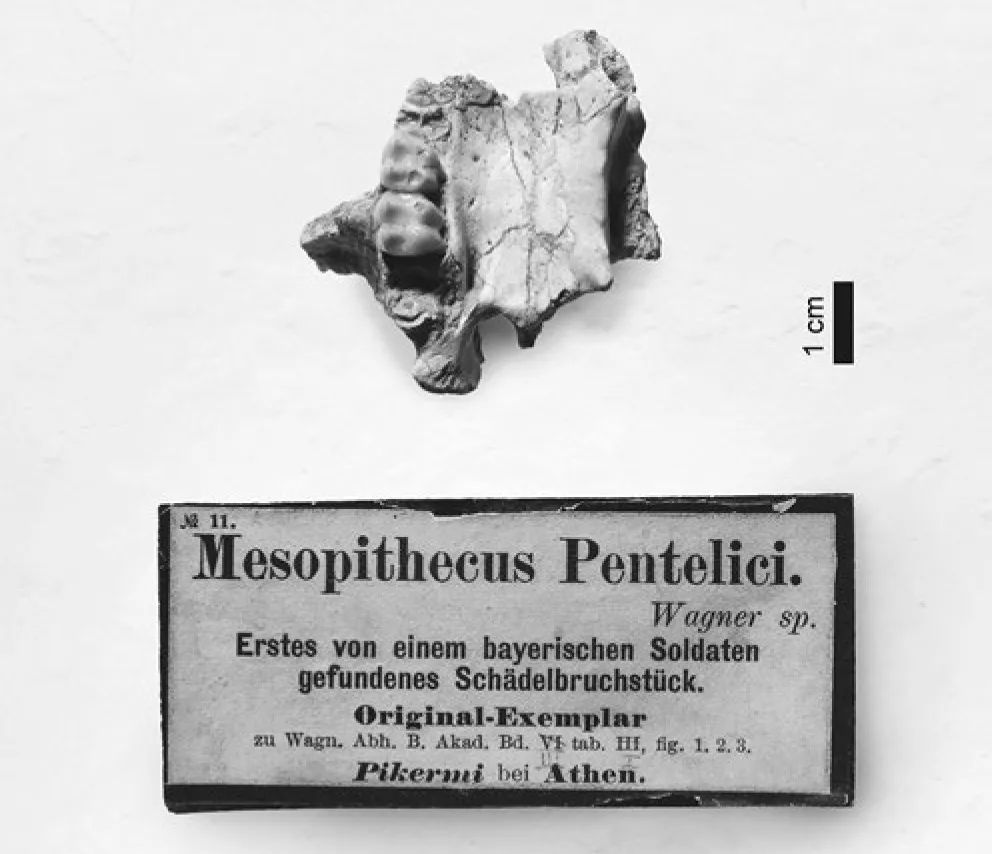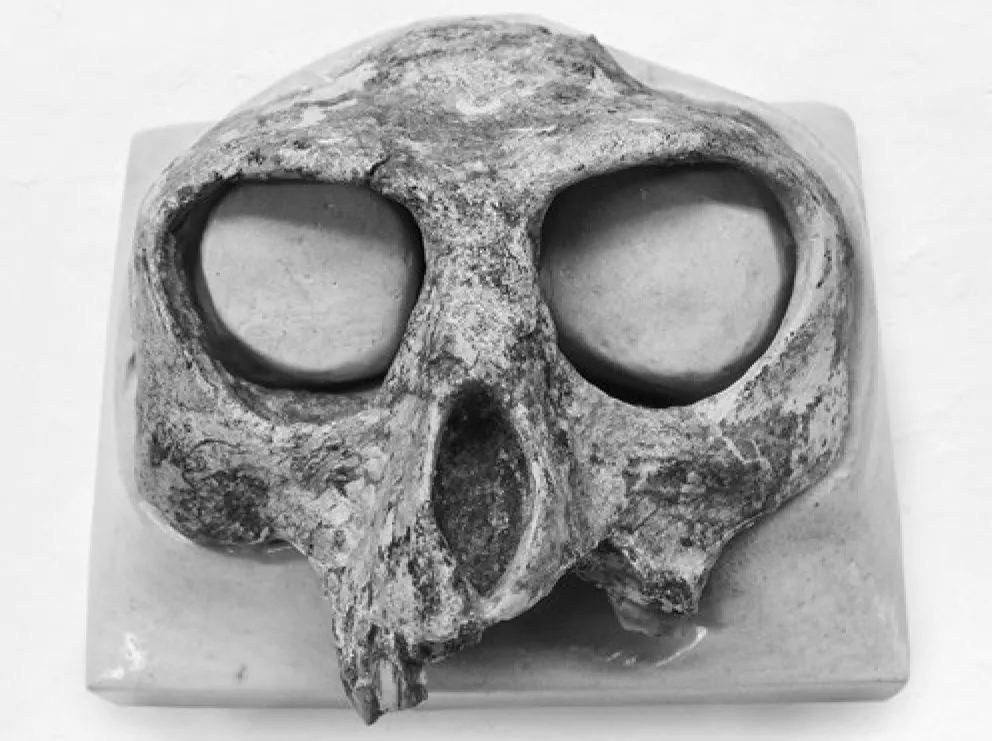
eBook - ePub
Ancient Bones
Unearthing the Astonishing New Story of How We Became Human
- English
- ePUB (mobile friendly)
- Available on iOS & Android
eBook - ePub
Ancient Bones
Unearthing the Astonishing New Story of How We Became Human
About this book
"Splendid and important... Scientifically rigorous and written with a clarity and candor that create a gripping tale... [Böhme's] account of the history of Europe's lost apes is imbued with the sweat, grime, and triumph that is the lot of the fieldworker, and carries great authority." —Tim Flannery, The New York Review of Books
In this "fascinating forensic inquiry into human origins" (Kirkus STARRED Review), a renowned paleontologist takes readers behind-the-scenes of one of the most groundbreaking archaeological digs in recent history.
Somewhere west of Munich, paleontologist Madelaine Böhme and her colleagues dig for clues to the origins of humankind. What they discover is beyond anything they ever imagined: the twelve-million-year-old bones of Danuvius guggenmosi make headlines around the world. This ancient ape defies prevailing theories of human history—his skeletal adaptations suggest a new common ancestor between apes and humans, one that dwelled in Europe, not Africa. Might the great apes that traveled from Africa to Europe before Danuvius's time be the key to understanding our own origins?
All this and more is explored in Ancient Bones. Using her expertise as a paleoclimatologist and paleontologist, Böhme pieces together an awe-inspiring picture of great apes that crossed land bridges from Africa to Europe millions of years ago, evolving in response to the challenging conditions they found.
She also takes us behind the scenes of her research, introducing us to former theories of human evolution (complete with helpful maps and diagrams), and walks us through musty museum overflow storage where she finds forgotten fossils with yellowed labels, before taking us along to the momentous dig where she and the team unearthed Danuvius guggenmosi himself—and the incredible reverberations his discovery caused around the world.
Praise for Ancient Bones:
"Readable and thought-provoking. Madelaine Böhme is an iconoclast whose fossil discoveries have challenged long-standing ideas on the origins of the ancestors of apes and humans."
—Steve Brusatte, New York Times-bestselling author of The Rise and Fall of the Dinosaurs
"An inherently fascinating, impressively informative, and exceptionally thought-provoking read."
—Midwest Book Review
"An impressive introduction to the burgeoning recalibration of paleoanthropology."
—Kirkus Reviews, STARRED review
Frequently asked questions
Yes, you can cancel anytime from the Subscription tab in your account settings on the Perlego website. Your subscription will stay active until the end of your current billing period. Learn how to cancel your subscription.
No, books cannot be downloaded as external files, such as PDFs, for use outside of Perlego. However, you can download books within the Perlego app for offline reading on mobile or tablet. Learn more here.
Perlego offers two plans: Essential and Complete
- Essential is ideal for learners and professionals who enjoy exploring a wide range of subjects. Access the Essential Library with 800,000+ trusted titles and best-sellers across business, personal growth, and the humanities. Includes unlimited reading time and Standard Read Aloud voice.
- Complete: Perfect for advanced learners and researchers needing full, unrestricted access. Unlock 1.4M+ books across hundreds of subjects, including academic and specialized titles. The Complete Plan also includes advanced features like Premium Read Aloud and Research Assistant.
We are an online textbook subscription service, where you can get access to an entire online library for less than the price of a single book per month. With over 1 million books across 1000+ topics, we’ve got you covered! Learn more here.
Look out for the read-aloud symbol on your next book to see if you can listen to it. The read-aloud tool reads text aloud for you, highlighting the text as it is being read. You can pause it, speed it up and slow it down. Learn more here.
Yes! You can use the Perlego app on both iOS or Android devices to read anytime, anywhere — even offline. Perfect for commutes or when you’re on the go.
Please note we cannot support devices running on iOS 13 and Android 7 or earlier. Learn more about using the app.
Please note we cannot support devices running on iOS 13 and Android 7 or earlier. Learn more about using the app.
Yes, you can access Ancient Bones by Madelaine Böhme,Rüdiger Braun,Florian Breier, Jane Billinghurst in PDF and/or ePUB format, as well as other popular books in Social Sciences & Military & Maritime History. We have over one million books available in our catalogue for you to explore.
Information
— Part 1 —
EL GRAECO AND THE SPLIT BETWEEN CHIMPANZEES AND HUMANS
– 1 –
QUESTIONING THE ORIGINS OF HUMANS
The Detective Work Begins

IN 2009 I embarked on a scientific adventure that, in hindsight, unfolded with all the twists and turns of a mystery novel. I was about to take on a professorship. My title was quite a mouthful, but it accurately captured my area of expertise—terrestrial paleoclimatology—which means I research what the climate used to be like on land. I was going to be part of a human evolution project co-managed by the Senckenberg Society for Nature Research and the University of Tübingen. In the middle of all the upheaval that comes with taking on a new position, I got a phone call from Nikolai Spassov, the director of the National Museum of Natural History in Sofia, Bulgaria.
He and I had been friends on a professional level for many years. In 1988, when I was still a young student, I had the opportunity to participate in digs in Bulgaria with him. We were investigating sites where remains of pre–ice age vertebrates had been found. It was a formative experience for me. I found it incredibly exciting to hold the remains of creatures that were part of an ecosystem that no longer existed. Every new detail we uncovered added to our picture of the lost world and helped bring it to life. From the beginning, Spassov was supportive as I dove in.
Spassov is one of the best mammal experts I know, a walking encyclopedia of amazing anatomical facts about animals that are alive today as well as animals that died out long ago. He taught me many things, including how to recognize that the bone I had just dug up was from the upper foreleg of a saber-toothed cat or what features revealed that the numerous deer bones we had just unearthed belonged to at least three different species. He probably wondered why a twenty-one-year-old geology student had such a passion for anatomical details, especially when she was on the dig team to study the geological features of the site. But he patiently answered all my questions, and I took advantage of that. Even back then, what I really wanted to study were extinct animals and plants in the places where they had lived.
Bulgarian Inspirations
Now, over twenty years later, Spassov was on the telephone, beside himself with excitement as he told me he had finally found what he had been searching for in Bulgaria for the past ten years: the fossilized remains of a great ape—a hominid, as experts call the family to which the gorillas, orangutans, chimpanzees, and modern humans all belong.
Spassov had dug up an upper premolar that showed typical hominid features and was probably 7 million years old. That amazed me, because according to research done by many of my colleagues, great apes had died out in Europe long before then. That had been the accepted school of thought for decades, and recent discoveries from Spain and Greece seemed to confirm its credibility. Spassov’s discovery, it occurred to me, completely contradicted it. What made things even more interesting was that he had made his find close to Azmaka near Chirpan in central Bulgaria, a region where no one would have expected him to find anything. The southwestern part of Bulgaria is the region known among experts for its wealth of evidence of extinct mammals.
The chances that Spassov had actually found the remains of a great ape in this area seemed as likely as his winning the jackpot in a lottery. But as I well knew, he was very good at what he did. Therefore, I agreed without any hesitation to join him on a dig that fall. Our primary goal would be to examine the geology and estimate the age of the site where the tooth was found.
For ten days that fall, Spassov and I worked intensively in the sandpit at Azmaka, along with four of my students, a small French team, and some Bulgarian colleagues. We established a geological timeline, surveyed the sediments and the sedimentary layers, and drilled rock cores in the exposed ground to get data about changes in the Earth’s magnetic field that would help us date the upper premolar Spassov had found. We also found other fossils, including the almost-complete skull of an elephant. Georgi Markov was the expert on fossil proboscideans on the dig, and he recognized it right away as belonging to the genus Anancus, one of the first true elephants. A hominid tooth and an Anancus skull—up until then, such combinations had been found only in 6.5-million-year-old sites in Africa. Other species of mammals found at Azmaka also indicated that the Bulgarian site was something special. The mood of the team became increasingly excited and focused. Finally, we were able to confirm Spassov’s estimated date.
IN THE LOWLANDS of Thrace in central Bulgaria, temperatures can reach 95 degrees Fahrenheit (35 degrees Centigrade) even in September. The warm evenings are sometimes the most pleasant time of day. We made the most of the balmy temperatures and met regularly in an outdoor restaurant that served authentic Balkan food. There were lamb kebabs and stewed lamb heads; traditional tomato, cucumber, pepper, and onion salad; and rakia, the local fruit brandy. We relaxed after long days in the field, and we talked.
On one of these warm evenings in Azmaka, I told Spassov about a 1949 paper by Bruno von Freyberg.2 In 1944, the German geologist had found the lower jawbone of a great ape in Pyrgos near Athens. Its unusual features had made it difficult to classify, but von Freyberg estimated it to be somewhat younger than finds made at the famous paleontological site of Pikermi, which was relatively nearby. Many researchers had dated the Pikermi site as being about 8.5 million to 7 million years old. Scientists at the time thought von Freyberg’s estimate was utter nonsense, because it was completely at odds with the generally accepted thinking that great apes had disappeared from Europe long before then. Therefore, in their opinion, there could not have been any highly developed great apes in Europe a couple of million years later. No one bothered to verify the age of von Freyberg’s find.
It hit both of us at the same time. The Bulgarian premolar and the lower jawbone from Greece could have come from the same time period. Could there really be a European great ape that dated back 7 million years? That would open a new chapter in the story of the early stages of human evolution and take us into uncharted territory. I felt I was on to something. We were on the cusp of changes of sensational proportions. What better subject to investigate as part of the scope of my new duties at the University of Tübingen than this very question?
What was important now was to reevaluate the jawbone and establish exact dates for the sites at Azmaka, Pyrgos, and Pikermi. The only problem was that no one had any idea where the lower jawbone and the other fossils from Pyrgos were. And there were rumors that the site at Pyrgos had been built over and was no longer accessible. Without the fossils, and without knowing their relationship to the rocks, there was no way to undertake the scientific analysis that was needed. But I wasn’t going to give up that easily. The lower jawbone had to exist somewhere, or so I hoped. After all, it had survived the chaos of World War II.
And so began a trail of discovery that would lead me back to the very beginnings of paleontology in the nineteenth century, a German army geologist in Athens during World War II, and an almost-forgotten safe.
– 2 –
THE GREEK ADVENTURE
The First Fossil Apes From Pikermi

SPRING 1838. A common soldier appears before representatives of the Bavarian zoological collection in Munich and offers to sell the renowned zoologist Johann Andreas Wagner fossils from Greece. The soldier believes the sparkling crystals they contain are valuable diamonds. Even though he knows the crystals are not diamonds but common calcite, Wagner realizes immediately that the man has indeed stumbled upon treasure. There in the soldier’s modest satchel, in among all the fragments of bone and horses’ teeth, lies something much more precious: the upper jawbone of a fossil primate.3
Wagner was famous for his explorations of the “primeval world,” as the past geological epochs of the world were then called. He had already studied many fossils. But there was a gap in the scientific knowledge that he and his colleagues were anxious to fill. The fossilized remains of lions, hyenas, elephants, and rhinoceroses had been found in many places in Europe and Asia, and this led the experts to conclude that these animals had once been much more widely distributed. And yet, until now, there had been virtually no ape or monkey fossils. How could it be that these species existed together in modern Africa but apes and monkeys were absent from the fossil sites? With the find from Greece, Wagner now held in his hand an important piece that had been missing from the primeval puzzle. After careful examination, he documented the find in 1839. He named it Mesopithecus pentelicus (“middle monkey from Mount Pentelicon”) and described it as a link between langurs (Old World monkeys) and gibbons (lesser apes).4
But how exactly had the fossils come into the soldier’s possession? That story is as fascinating as the fossils’ journey to the Bavarian State Collection of Zoology in Munich. In 1836, the British historian George Finlay was combing the area at the foot of Mount Pentelicon, northeast of Athens, in search of sites from antiquity, when he came across some puzzling bones. He collected a few fossils and showed them to Anton Lindermayer, a German doctor he had befriended, who immediately recognized them as the fossilized bones of mammals.
Finlay and Lindermayer belonged to a group of Western Romantics who ardently admired ancient Hellas and called themselves Philhellenes. Their fascination with the country’s past had drawn both men to Greece. Supporters of this intellectual movement included writers and philosophers such as Lord Byron, Victor Hugo, Johann Wolfgang von Goethe, Friedrich Schiller, and Alexander von Humboldt. Philhellenes sided with the Greeks in the nineteenth-century Greek War of Independence against the Ottoman Empire.

The upper jawbone found by a Bavarian soldier in Pikermi and now in the collection of the Bavarian State Collection for Palaeontology and Geology in Munich. It was used by Johann Andreas Wagner in 1839 to document a species he named Mesopithecus pentelicus.

An almost complete skull of Mesopithecus pentelicus
Illegal Greek Souvenirs
In 1827, after a civil war that lasted for many years, the guerilla fighters and the Greeks, with the help of the major powers France, Great Britain, and Russia, finally managed to defeat the Turks and bring independence to Greece. But conditions in the young republic remained unsettled, and in 1832, the major powers decided to turn Greece into a monarchy. This was the only circumstance under which they were prepared to extend the debt-ridden country the credit it so desperately needed. They suggested to the Greek national assembly that it choose a European prince as the country’s king. After two other candidates had politely declined, the assembly finally settled on sixteen-year-old Prince Otto of Bavaria, the second son of Bavaria’s King Ludwig I. That was a less-than-ideal solution, as Prince Otto was still a minor...
Table of contents
- Cover
- Title Page
- Contents
- Foreword
- Introduction
- Part 1: El Graeco and the Split Between Chimpanzees and Humans
- Part 2: The Real Planet of the Apes
- Part 3: The Cradle of Humanity: Africa or Europe?
- Part 4: Climate Change as a Driver of Evolution
- Part 5: What Makes Humans Human
- Part 6: The Lone Survivor
- Epilogue
- Acknowledgments
- Notes
- Illustration Credits
- Index
- Photos
- Copyright Page